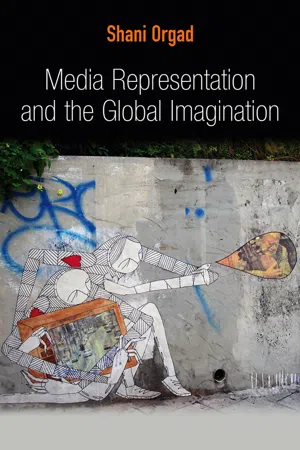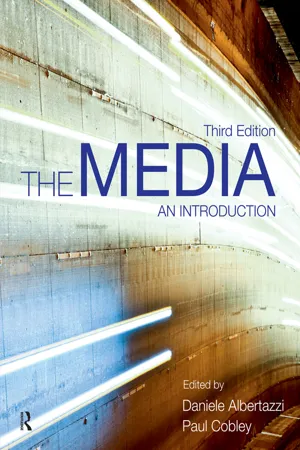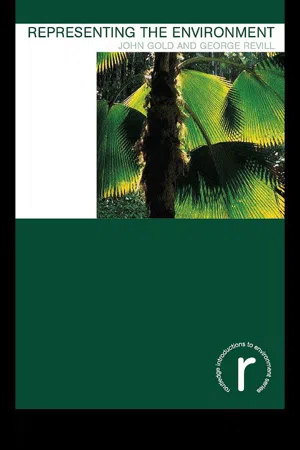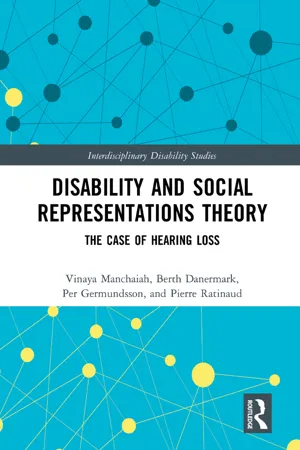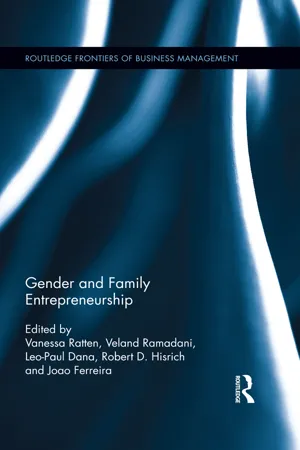Social Sciences
Media Representations
Media representations refer to the ways in which the media portrays and constructs images, ideas, and narratives about people, events, and issues. These representations can shape public perceptions and influence social attitudes. They are influenced by various factors such as cultural norms, power dynamics, and media ownership, and can have significant impacts on individuals and society.
Written by Perlego with AI-assistance
Related key terms
8 Key excerpts on "Media Representations"
- eBook - ePub
- Shani Orgad(Author)
- 2014(Publication Date)
- Polity(Publisher)
This section provides an overview of some of the central ‘stories’ in research on Media Representations. It provides a selective map of some key accounts, organized around three questions, on which the discussion in the literature centres: (1) what are Media Representations? (2) what work do Media Representations do (what do they accomplish)? and (3) why do Media Representations matter? The answers to these questions vary and rest on diverse and conflicting epistemological, theoretical and analytical premises. The point is not to argue that one account is better or more ‘truthful’ than another, nor to suggest that we should somehow integrate all approaches and reconcile the tensions that are evoked by their juxtaposition. Rather, the purpose is to provide an account of the central ideas and claims that inform the research on Media Representations on which this book draws. I highlight the relevance and utility of certain well-established theories and concepts for exploring the ‘work’ of Media Representations in the contemporary global media environment, as well as pointing to some of their limits.What are Media Representations?Representations are images, descriptions, explanations and frames for understanding what the world is and why and how it works in particular ways (Hall, 1997). Of course, cultural representations have a long history and can be seen in the form of totemic objects created by religious societies as projections of their values and beliefs. In broad terms, any object, for example, a building, an item of clothing, an artefact, can be seen as a representation that carries meanings beyond its immediate function and use. What distinguishes Media Representations from these other representational objects is that their essence is to represent. In other words, their main function is to produce meaning, to capture in some way ‘reality’ in signs.When we talk about Media Representations we are referring to texts (in the broad sense, which includes images) that circulate in the media space and carry symbolic content: news photographs and articles, advertisements, radio programmes, YouTube videos, blogs, Facebook pages, etc. ‘Representation’ refers to the process of re-presenting, the process by which members of a culture use systems of signs to produce meaning. This highlights that representation is an active process of meaning production, the products of which are Media Representations, that is, texts and images. The study of Media Representations brings together these two meanings: it centres on analysing representations as texts, by looking at their textual, auditory, visual and discursive properties, in order to establish a better understanding of the ‘work’ (Hall, 1997) that they do, that is, the process - eBook - ePub
Literacy in Multimedia America
Integrating Media Education Across the Curriculum
- Ladislaus M Semali(Author)
- 2017(Publication Date)
- Routledge(Publisher)
To get at the values, interests, and desires in Media Representations, one has to examine the use of language, or signs and images that stand for or represent things. I suppose to do this is complex simply because the meaning so produced or constructed by representation is not a universal truth or neutral fact and cannot be read in a straightforward manner. As explained in previous chapters, meaning is entangled in social, cultural, economic, and political settings, which preside over the context through which both the reader/viewer and the communicator engage in an exchange and interpretation of messages. Hall (1997) reminds us that when we decide to examine the representation of an event or people, we are in fact entering into the very constitution of things; this is a constitutive process, as important as the economic or material “base” in shaping social subjects and historical events—not merely “a reflection of the world after the event” (p. 5).For Hall, therefore, media representation is a way of giving things meaning by how we represent them—the words we use about them, the images of them we produce, the emotions we associate with them, the ways we classify and conceptualize them, the values we place on them (p. 3). In other words, media representation refers to the way images and language actively construct meanings according to sets of conventions shared by and familiar to makers (producers) and audiences (viewers). In this sense, it is a continuous struggle over meaning.CRITICAL LITERACY AND MEDIA LITERACY CURRICULUMCritical literacy is a contested educational ideal. Even though “critical” pedagogy has been en vogue for the past fifteen years, scholars continue to question what it means to be critical and how such a concept can be implemented across the curriculum. As I explained in Chapter 3 - eBook - ePub
The Media
An Introduction
- Daniele Albertazzi, Paul Cobley(Authors)
- 2013(Publication Date)
- Routledge(Publisher)
Part 5 Media Representations Introduction Daniele Albertazzi and Paul CobleyThis part of the book is devoted to essays about the representation in different media of various facets of life. That said, the media and forms that tend to dominate in this section are television, film, magazines, newspapers, news and advertising. One reason for this – and the reason that representation is so important – is that these media seem to be so omnipresent. Furthermore, although the media are clearly industries and part of national and continental media systems, most consumers of media encounter media through representations. This is where they interact with media most directly, in spite of the fact that the economic bearing of the media industries may be having an impact on their lives in different ways. In fact, the essays in this part seek to demonstrate that representations not only contribute to how we experience facets of life, but often representations actually create those facets in order that they can be experienced.Three concepts are important, here, and are worked through in these chapters. These are: representation, ideology and discourse. You need to gain a sense of what each of these means by the way that they are used in each of the chapters in this part, by the recommended further reading and by your own reading round the topic. (The following offer a good start to the latter task: Hall (1997) on representation; Eagleton (1991) on ideology; and Coupland and Jaworski (2001) on discourse). However, a few words on the topics are offered here to orientate your reading.Because the rendering of any object in the world cannot be that which it renders, representations are never straightforward presentations. Rather, they are always representations of the world and the relationships between people in it. What is common to understandings of the act of representation is that representing is not a simple reflection of the world but a creation of something that is almost new. It is impossible for us to think of ourselves, our gender, ‘race’, sexuality, for example – without involving the changing images, ideas and values associated with facets of our identity which surround us: representations. These representations are ubiquitous and make such a contribution to the production of our ‘common sense’ understandings of the world that we can hardly imagine being without them. Yet, of course, they are not without problems: much mainstream portrayal of, say, religious issues, bodies, sexualities and national identities, to mention just a few of the topics covered in this part, is said to share stereotypical notions of what is acceptable or unacceptable, of how people ‘should’ experience and express their sexuality, what is ‘appropriate’ to their age or gender, how they are affected by their national identity, how their religious beliefs are supposed to make them behave, and so on. These stereotypes can be said to serve specific interests and have very real effects – think, for example, of the extent to which certain representations of Islamic communities can contribute to heightening tensions in society following 9/11 and how such a climate of fear can be used to justify the approval of draconian anti-terror legislation. Representations can (and indeed do) serve specific interests, held by specific groups, individuals and/or organisations in specific historical and social circumstances. In other words, representations are ideological - eBook - ePub
- John R. Gold, George Revill(Authors)
- 2004(Publication Date)
- Routledge(Publisher)
3 Representations in context
This chapter:- examines strategies for studying the audience’s consumption of environmental representations;
- considers the contexts in which representations are produced;
- explores the concepts of cultural politics, ideology and discourse;
- provides a range of basic approaches for the study of the discursive role of representations in society.
Audiences and the media
The media occupy a central place in any study of environmental representations. Traditionally, ‘media’ meant the ‘media of mass communication’, by which technologically based systems transmitted content (or messages) through print, broadcasting, posters or film to remote and scattered audiences. More recently, though, the idea of what constitutes ‘media’ has expanded dramatically. If media transmit content in symbolic form to an audience, then architecture, clothes, recorded music, food packaging, jewellery and skin tattoos are legitimately media. Moreover, many new media no longer conform to the established model. The convergence of television, computers, wireless technology, digital networks and mobile telephones brings patterns of use that bear little resemblance to the ‘fireside’ consumption of early radio and television programmes.The word ‘consumption’ needs clarification. We stressed the importance of the audience’s active participation in shaping the meaning of environmental representations at the end of Chapter 2 . In this context, it might seem that media research has much to offer, given that audience studies have preoccupied media researchers since the 1920s (McQuail, 1997). Sadly, however, the findings of that research have proven continually disappointing. Researchers have often attempted to trace direct and measurable audience response to communication, usually finishing by either showing no discernible effects or recognising that any effects are very difficult to assess and quantify. The problem lies partly with conceptual understanding and partly with methodology. In terms of the former, researchers reluctantly accept that the media do not function in isolation and that, in most circumstances, any impact that they might have is itself mediated - eBook - ePub
- Rosalind Gill(Author)
- 2015(Publication Date)
- Polity(Publisher)
1Gender and the MediaIntroduction: Representations Matter
WE live in a world that is stratified along lines of gender, race, ethnicity, class, age, disability, sexuality and location, and in which the privileges, disadvantages and exclusions associated with such categories are unevenly distributed. We also live in a world which is increasingly saturated by media and information and communication technologies. In many respects, the last four decades of research in feminist media studies has been an attempt to explore the relationship between these two facts.Starting from the proposition that representations matter, feminist analyses of the media have been animated by the desire to understand how images and cultural constructions are connected to patterns of inequality, domination and oppression. Sometimes this has involved examining representations and textual practices in some detail. Sometimes it has emphasized the active, creative negotiations that audiences make with texts. Sometimes the pleasures offered by the media have been foregrounded, and at other times their ideological impact has been stressed. Occasionally, researchers have gone ‘behind-the-scenes’ to look at the production of particular media, or at the political economy of media industries which means that some media products are made, while others are not even dreamed. Taken together this research has produced a field that is vibrant, exciting and diverse. It is a field that strives to be both theoretically engaged and empirically driven, and which produces rigorous analyses in the context of ethical and political commitments to creating a more just world.The study of gender and media is extraordinarily heterogeneous. Researchers may agree that cultural representations constitute an important site for examination and struggle, but on all else they disagree. The field is thus characterized by a plurality of different approaches and perspectives: different methodologies, different theoretical perspectives, different epistemological commitments, different understandings of power, different conceptualizations of the relationship between representations and ‘reality’, and different understandings of how media images relate to individuals’ sense of identity and subjectivity. A feeling for the differences and debates should emerge throughout this book, and the diversity of different approaches is dealt with in detail in chapter 2 - eBook - ePub
Disability and Social Representations Theory
The Case of Hearing Loss
- Vinaya Manchaiah, Berth Danermark, Per Germundsson, Pierre Ratinaud(Authors)
- 2019(Publication Date)
- Routledge(Publisher)
As discussed earlier, there is no common and generally accepted definition of culture. However, there are overlapping areas of interest and thoughts between cross-cultural researchers and researchers using the Social Representations Theory. The relationship between culture and social representations has been discussed in different contexts.Gerard Duveen (2007) suggests that the terms refer to different levels of analysis and that they can be distinguished by noting that while “social representations always bear on specific objects, the term culture refers to a more diffuse body of representations which serve to characterize something distinctive about a community” (p. 557). Duveen (2007) underlines that culture is not a homogenous entity that is free of internal divisions, and that the broad term culture becomes accessible through the observation and analysis of representations:Culture, then, can be taken as referring to a broader network of representations held together as an organized whole by a community. Social representations, in this sense, can be seen as particular cultural forms, and the analysis of social representations will always refer back in some way to the cultural context in which they take shape. (p. 545)Viewed from this perspective, a dynamic process emerges in which transformed social representations affect how culture develops, and at the same time cultural change affects our social representations through constant mutual influence. Sartawi (2015) highlights a dual function of social representations with both a prescriptive and a transformative function, and argues that one strength of the theory is its conceptualization of a dual function of social knowledge. In one way, representations act as guides that provide groups with tools to navigate in and make sense of their environment. Additionally, they provide a foundation of knowledge, and the necessary means, for a group to cope with, and adapt to, cultural change (see Chapter 2 - eBook - ePub
Media and Society
Power, Platforms, and Participation
- Nicholas Carah(Author)
- 2021(Publication Date)
- SAGE Publications Ltd(Publisher)
We come to know and understand the world and our place in it via Media Representations and technologies. Second, social institutions and processes gradually adapt to the routines and practices of media institutions. Politics and government are now substantially organized around the production and management of media narratives. Professional sport is largely a performance for television broadcasts. Third, our private and public spaces are organized around material media technologies. The television is an important object in the layout of our homes. Urban spaces are filled with mobile reception towers and WiFi coverage that enable us to remain connected to the web via our smartphones. Media frame and represent the social world in routine and organized ways. Couldry (2003: 1) suggests that we ought to pay attention to the ‘media’s role in ordering our lives, and organising social space’. In media-dense societies, media are essential to how we imagine our ‘lives together as social beings’ via political institutions and shared national and cultural identities. Media are the primary site through which we come to know the larger social and political structures within which any meanings, practices and identities might make sense to us. Regardless of the specific messages the media convey, their primary claim is often simply that they reflect our world, way of life and values within power relationships. Media promote the idea that the social world has a ‘centre’ of power and legitimacy, and that they have a ‘privileged relation to that “centre”’ (Couldry 2003: 45). Media ‘naturalize’ the idea ‘that there is a social centre to be re-presented to us’ and that the media are the legitimate site for producing and managing that process of representation. Processes of representation are organized in media rituals which legitimate the idea that ‘the media is our access to the social centre’ (Couldry 2003: 2) - eBook - ePub
- Vanessa Ratten, Veland Ramadani, Leo-Paul Dana, Robert D. Hisrich, Joao Ferreira(Authors)
- 2017(Publication Date)
- Routledge(Publisher)
In this sense, the mass media “played an important or perhaps decisive role in the emancipation of people from ignorance and in the construction of the ambience of “general knowledge” that characterizes our time” 9 (Sousa, 2006: 539). In fact, the mass media are a powerful weapon, either as a strategy/medium for building collective identities, or as vehicles of gender identity. Indeed, the mass media seem to be at the heart of identity issues. In this order of ideas, several researches about gender representations in the mass media have appeared. For example, Goffman (1976) looked at more than 500 advertisements where women, men and children came along and concluded that advertisements represent the conventions and social roles of each gender in society. Also Kramarae (1981) studied the representation of the sexes in adolescent publications, from which she concluded that the interests of girls and boys differed according to the behaviours that are expected of them. On the other hand, Myra Macdonald (1995) looked more specifically at the representation of women in Western media, emphasizing the importance of discourse in the media, which is associated with the institutional structures of power and authority (Macdonald, 1995: 43). More recently, Rosalind Gill (2007) also addressed the issue of gender in the mass media today. For the author, the pertinence of the study of the relationship between gender and the media is that media are simultaneously disclosure agents of feminist ideas and, on the other hand, they still convey images and patterns alluding to a latent sexism (Gill, 2007: 2). On the other hand, for Meyers (1999), the mass media play a role of maintaining the hegemonic consensus or the status quo in which women, like the elderly, blacks, homosexuals, among others, appear as subordinate or inferior groups
Learn about this page
Index pages curate the most relevant extracts from our library of academic textbooks. They’ve been created using an in-house natural language model (NLM), each adding context and meaning to key research topics.
